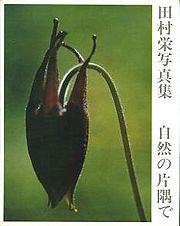
Sakae Tamura (nature photographer)
Encyclopedia

Tamura was born in Chiba
Chiba Prefecture
is a prefecture of Japan located in the Kantō region and the Greater Tokyo Area. Its capital is Chiba City.- History :Chiba Prefecture was established on June 15, 1873 with the merger of Kisarazu Prefecture and Inba Prefecture...
in 1910, but his family moved to Tokyo in 1924. Under the influence of his father, an amateur photographer, he started taking photographs in 1927.
Tamura worked from 1936 till 1973 in a succession of editorial posts, mostly preparing educational materials about nature. The first of these was within Kōgasha , where he worked on the photography magazine Gekkan Kogata Kamera . He subsequently moved to Seibundō Shinkōsha , where he was the chief editor of the magazine of science for children Kodomo no Kagaku and the astronomy magazine Tenmon Gaido .
Tamura's book of photography of insects, showing the activities and life-cycles of insects, made him an innovator in Japan, where insect photography had previously been limited to unimaginative depictions of dead specimens.
Tamura won an award from the Ministry of Education
Ministry of Education, Culture, Sports, Science and Technology (Japan)
The , also known as MEXT or Monkashō, is one of the ministries of the Japanese government.The Meiji government created the first Ministry of Education in 1871....
in 1951 for the book Konchū no seitai.
Between 1954 and 1960, Tamura took many photographs of bird life, and the increasing threats to this, along the stretch of the Tama River
Tama River
The is a major river in Yamanashi, Kanagawa and Tokyo Prefectures on Honshū, Japan. It is officially classified as a Class 1 river by the Japanese government....
between Tokyo
Tokyo
, ; officially , is one of the 47 prefectures of Japan. Tokyo is the capital of Japan, the center of the Greater Tokyo Area, and the largest metropolitan area of Japan. It is the seat of the Japanese government and the Imperial Palace, and the home of the Japanese Imperial Family...
and Kawasaki
Kawasaki, Kanagawa
is a city located in Kanagawa Prefecture, Japan, between Tokyo and Yokohama. It is the 9th most populated city in Japan and one of the main cities forming the Greater Tokyo Area and Keihin Industrial Area....
, increasingly polluted and with an increasing percentage of its banks used for group leisure pursuits. In a book-length anthology of these published in 1962, he pointed out the decrease in the variety of bird life, and warned of the danger of further increases to come. Photographs from the book were exhibited in the National Science Museum of Japan
National Science Museum of Japan
The is located in the northeast corner of Ueno park in Tokyo. Opened in 1871, the museum has had several names, including Ministry of Education Museum, Tokyo Museum, Tokyo Science Museum, the National Science Museum of Japan, and currently the National Museum of Nature and Science as of 2007...
in 1963.
Tamura died in 2003.
Books
- Tōdai no hanashi . Tokyo: Tōa Shorin, 1943. A book for children. Konchū no seitai: Raika shashinshū / Closeups on Insects. Tokyo: Seibundo-Shinkosha, 1951. Most of the text in Japanese only, but with terse captions in English as well. Konchū . Iwanami Shashin Bunko. Tokyo: Iwanami, 1953. A joint work.
- Tamagawa no tori / Birds of River Tama. Tokyo: Seibundo-Shinkosha, 1961. With captions and some text in English as well as Japanese. Tamura Sakae shashinshū: Shizen no katasumi de . Tokyo: Seibundo-Shinkosha, 1965. Photographs of plants, insects, reptiles and birds, as noticed often hidden away. Mostly black and white, some color. Kamakura kaidō . Tokyo: Seibundo-Shinkosha, 1990. ISBN 4-416-89000-1. Color and black and white photographs of sights of nature along the Kamakura KaidōKamakura Kaidois the generic name of a great number of roads built during the Kamakura period which, from all directions, converged on the military capital of Kamakura, Kanagawa Prefecture, Japan. The term itself however was created probably during the Edo Period to mean simply any old road going to Kamakura; it...
, an ancient road.
Sources
- Neichā wārudo: Chikyū ni ikiru / Nature World: Life on Earth. Tokyo: Tokyo Metropolitan Museum of Photography, 1997. Exhibition catalogue, with texts and captions in Japanese and English.
- Nihon no shashinka / Biographic Dictionary of Japanese Photography. Tokyo: Nichigai Associates, 2005. ISBN 4-8169-1948-1. Despite the English-language alternative title, all in Japanese.
- Sekiji, Kazuko. “Nature World: Life on Earth.” 185–91. In Nature World: Life on Earth.
- Unno, Kazuo . "Tamura Sakae: Konchū no seitai" . Unno Kazuo no dejitaru konchūki / Kazuo Unno's Insects World of Digital. 14 December 2007. Accessed 8 June 2008.

